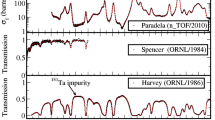Summary
Populations of G1-phase Chinese hamster cells in stirred suspensions containing various concentrations of DMSO were irradiated with 250 kV X-rays or various heavy charged-particle beams. Chemical radioprotection of cell inactivation was observed for all LET values studied. When cell survival data were resolved into linear and quadratic components, the extent and concentration dependence of DMSO protection were found to be different for the two mechanisms. The chemical kinetics of radioprotection for single-events were similar for LET values up to those which gave the maximum RBE. DMSO protected to a lesser extent against energetic argon ions at an median LET of ∼ 220 keV/µm. These data could indicate the contribution of indirect action by hydroxyl radicals and hydrogen atoms to cell inactivation by single-hit and double-hit mechanisms for various radiation qualities. The decrease in RBE observed at very high LET may result, in part, from reduced yields of water radicals at 10−9−10−8 s resulting from radical recombination mechanisms within the charged particle tracks.
Similar content being viewed by others
References
Adams, G. E.: Personal communication
Ashwood-Smith, M. J.: The radioprotective action of DMSO and various other sulfoxides. Int. J. Radiat. Biol.3, 41–48 (1961)
Ashwood-Smith, M. J.: Radioprotective and cryoprotective properties of DMSO. In: Dimethyl Sulfoxide, Vol. 1, Basic Concepts of DMSO, p. 147 (Jacob, S. W., Rosenbaum, E. E., Wood, D. C., Eds.). New York: Dekker 1971
Bird, R. P., Burki, H. J.: Survival of synchronized Chinese hamster cells exposed to radiation of different linear-energy transfer. Int. J. Radiat. Biol.27, 105–120 (1975)
Chapman, J. D., Blakely, E, A., Smith, K. C., Urtasun, R. C.: Radiobiological characterization of the inactivating events produced in mammalian cells by helium and heavy ions. Int. J. Radiat. Oncol. Biol. Phys.3, 97–102 (1977)
Chapman, J. D., Dugle, D. L., Reuvers, A. P., Gillespie, C. J., Borsa, J.: Chemical radiosensitization studies with mammalian cells growing in vitro. In: Radiation Research - Biomedical, Chemical and Physical Perspectives, p. 752 (Nygaard, O. F., Adler, H. I., Sinclair, W. K., Eds.). New York: Academic Press 1975
Chapman, J. D., Gillespie, C. J., Reuvers, A. P., Dugle, D. L.: The inactivation of Chinese hamster cells by X-rays: The effects of chemical modifiers on single- and double-events. Radiat. Res.64, 365–375 (1975)
Chapman, J. D., Reuvers, A. P., Borsa, J., Greenstock, C. L.: Chemical radioprotection and radiosensitization of mammalian cells growing in vitro. Radiat. Res.56, 291–306 (1973)
Chapman, J. D., Reuvers, A. P., Borsa, J., Petkau, A., McCalla, D. R.: Nitrofurans as radiosensitizers of hypoxic mammalian cells. Cancer Res.32, 2616–2624 (1972)
Chapman, J. D., Reuvers, A. P., Doern, S. D., Gillespie, C. J., Dugle, D. L.: Radiation chemical probes in the study of mammalian cell inactivation and their influence on radiobiological effectiveness. In: Proceedings of Fifth symposium on microdosimetry, p. 775 (Booz, J., Ebert, H. G., Smith, B. G. R., Eds.). Luxembourg: Commission of European Communities 1976
Curtis,, S. B.: Calculated LET distributions of heavy ion beams. Int. J. Radiat. Oncol. Biol. Phys.3, 87–91 (1977)
Dugle, D. L., Gillespie, C. J., Chapman, J. D.: DNA breaks repair, and survival in X-irradiated mammalian cells. Proc. Natl. Acad. Sci. (USA)73, 809–812 (1976)
Gillespie, C. J., Chapman, J. D., Reuvers, A. P., Dugle, D. L.: The inactivation of Chinese hamster cells by X-rays: Synchronized and exponential cell populations. Radiat. Res.64, 353–364 (1975)
Gillespie, C. J., Dugle, D. L., Chapman, J. D., Reuvers, A. P., Doern, S. D.: DNA damage and repair in relation to mammalian cell survival: Implications for microdosimetry. In: Proceedings of Fifth symposium on microdosimetry, p. 799 (Boot, J., Ebert, H. G., Smith, B. G. R., Eds.). Luxembourg: Commission of European Communities 1976
Kellerer, A. M., Rossi, H. H.: The theory of dual radiation action. Curr. Top. Radiat. Res.8, 85–158 (1972)
Manney, T. R., Brustad, T., Tobias, C. A.: Effects of glycerol and anoxia on the radiosensitivity of haploid yeasts to densely ionizing particles. Radiat. Res.18, 374–388 (1963)
Neary, G. J.: Chromosome aberrations and the theory of RBE (Relative Biological Effectiveness). I. General considerations. Int. J. Radiat. Biol.9, 477–502 (1965)
Reuvers, A. P., Greenstock, C. L., Borsa, J., Chapman, J. D.: Studies on the mechanism of chemical radioprotection by dimethyl sulphoxide. Int. J. Radiat. Biol.24, 533–536 (1973)
Ritter, M. A., Cleaver, J. E., Tobias, C. A.: High-LET radiations induce a large proportion of nonrejoining DNA breaks. Nature266, 653–655 (1977)
Takeshita, K., Sawada, S.: Lethal effects of 14-MeV fast neutrons on frog eggs and cultured mammalian cells. In: Biological effects of neutron irradiation, pp. 245–255. Vienna: I.A.E.A. 1974
Tobleman, W. T., Cole, A.: Repair of sublethal damage and oxygen enhancement ratio for lowvoltage electron beam irradiation. Radiat. Res.60, 355–360 (1974)
Todd, P.: Reversible and irreversible effects of densely ionizing radiations upon the reproductive capacity of cultured mammalian cells. Med. College Virginia Quart.1, 2–14 (1966)
Vos, O., Kaalen, M. C. A.: Protection of tissue-culture cells against ionizing radiation. II. The activity of hypoxia, DMSO, dimethylsulfone, glycerol, and cysteamine at room temperature and at −196° C. Int. J. Radiat. Biol.5, 609–621 (1962)
Ward, J. F.: Molecular mechanisms of radiation-induced damage to nucleic acids. In: Advances in Radiation Biology, Vol. 5, pp. 182–239 (Lett, J. T., Adler, H. I., Eds.). New York: Academic Press 1975
Author information
Authors and Affiliations
Rights and permissions
About this article
Cite this article
Chapman, J.D., Doern, S.D., Reuvers, A.P. et al. Radioprotection by DMSO of mammalian cells exposed to X-rays and to heavy charged-particle beams. Radiat Environ Biophys 16, 29–41 (1979). https://doi.org/10.1007/BF01326894
Received:
Issue Date:
DOI: https://doi.org/10.1007/BF01326894




